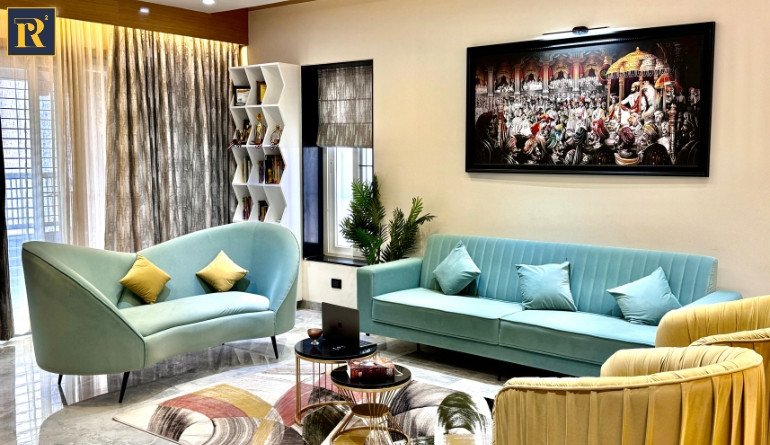R Square Associates : Gangapur Road, shahid Circle, Above Quality Fruits, Nashik -422013
Living room interior design

Living room interior design
"Living room interior design by R-Square Interior aims to create a functional and inviting space for relaxation, entertainment, and socializing. Key elements include thoughtful furniture arrangement, harmonious color schemes, layered lighting, and personalized decor. By balancing comfort with style and functionality, R-Square Interior enhances the overall ambiance of the home."
Layout and Space Planning:
Begin by assessing the size, shape, and architectural features of the living room. Plan the layout to optimize traffic flow and create distinct zones for seating, entertainment, and other activities.
Furniture Selection:
Choose furniture pieces that are comfortable, proportionate to the space, and complement the overall style of the room. Key items include sofas, armchairs, coffee tables, side tables, and media consoles. Consider the arrangement to encourage conversation and accommodate the needs of occupants.
Color Palette:
Select a color scheme that sets the mood and complements the style of the living room. Neutral tones like whites, grays, and beige create a versatile backdrop, while accent colors can add personality and visual interest. Consider using textures and patterns to add depth to the design.
Lighting Design:
Incorporate a layered lighting scheme that includes ambient lighting (general illumination), task lighting (for reading or specific activities), and accent lighting (to highlight artwork or architectural features). Natural light should also be maximized with well-placed windows and appropriate window treatments.
Entertainment and Media:
Plan for entertainment needs such as television viewing, gaming, or listening to music. Consider the placement of media equipment, storage for media components, and comfortable seating arrangements that optimize viewing angles.
Decorative Elements:
Personalize the living room with decorative elements that reflect your style and interests. This can include artwork, sculptures, decorative pillows, rugs, and plants. Use these elements to add color, texture, and personality to the space.
Storage Solutions:
Incorporate functional storage options to keep the living room organized and clutter-free. This can include built-in shelves, cabinets, storage ottomans, or multi-functional furniture pieces with hidden storage compartments.
Comfort and Coziness:
Enhance comfort with plush seating, soft textiles like throw blankets and cushions, and area rugs that add warmth and acoustical benefits. Create inviting spaces for relaxation and social gatherings.
Flow and Connectivity:
Ensure a seamless flow between the living room and adjacent spaces such as dining areas or entryways. Consider architectural features, furniture placement, and visual continuity to create a cohesive and connected living environment.
Seasonal Updates:
Refresh the living room decor seasonally with simple updates such as changing throw pillows, adding seasonal decorations, or adjusting lighting to create different moods throughout the year.
Functional Zones:
Divide the living room into functional zones based on activities such as lounging, entertaining, and reading. Arrange furniture to define these zones while maintaining a cohesive overall layout.
Rugs and Flooring:
Choose rugs that anchor seating areas and add comfort underfoot. Consider the size, shape, and material of the rug to complement the furniture and enhance the aesthetic of the room. Coordinate flooring materials such as hardwood, tile, or carpet to harmonize with the overall design.
Window Treatments:
Select window treatments that provide privacy, control natural light, and complement the decor. Options include curtains, drapes, blinds, shades, or a combination for versatility in light control and style.
Focal Point:
Create a focal point in the living room, such as a fireplace, large artwork, or a statement piece of furniture. Arrange furniture around this focal point to draw attention and create visual interest.
Scale and Proportion:
Ensure that furniture and decor are proportionate to the size of the room. Avoid overcrowding or under-furnishing by selecting pieces that fit comfortably within the space and allow for easy movement around the room.
Mixing Styles:
Experiment with mixing different styles and materials to create a layered and eclectic look. Balance contemporary pieces with vintage finds, or incorporate elements of different cultural influences for a personalized and curated aesthetic.
Versatile Seating:
Provide flexible seating options to accommodate different activities and the number of occupants. Consider incorporating ottomans, benches, or movable chairs that can be rearranged for various seating arrangements and social gatherings.
Art and Wall Decor:
Use wall art, mirrors, and decorative accents to enhance the walls and add personality to the living room. Arrange artwork at eye level and in proportion to furniture for optimal visual impact.
Technology Integration:
Incorporate technology seamlessly into the living room design with hidden wiring, built-in speakers, and media consoles that blend with the overall decor. Consider wireless charging stations or smart home devices for added convenience.
Personal Touches:
Infuse the living room with personal touches such as family photos, travel souvenirs, or heirloom pieces that tell a story and create a sense of belonging and warmth.
Outdoor Integration:
If the living room opens to an outdoor space such as a patio or garden, create a seamless transition between indoor and outdoor areas with coordinated decor, furnishings, and landscaping elements.
Sustainable Design:
Choose eco-friendly materials and furnishings that promote sustainability and reduce environmental impact. Look for certified wood products, low-VOC paints, and energy-efficient lighting options to create a greener living environment.
- Best Residential Interior Designers in Nashik
- Top Interior Contractors in Nashik
- Commercial Interior Design Services in Nashik
- Turnkey Contracting in Nashik
- Best Interior Designers in Nashik
- Interior Design Services
- Residential Interiors
- Commercial Interiors
- Before After
- Products and Materials
- Residential
- Developers
- Commercial
- Turnkey Contracting
- Home Design with R-Square Interior
- Bedroom design
- Living room interior design
- Office interior design
- Interior decorator
- Interior Design
- Interior design firm near me
- Room design at R-square interior
- Interior design architecture
- Landscape design solutions
